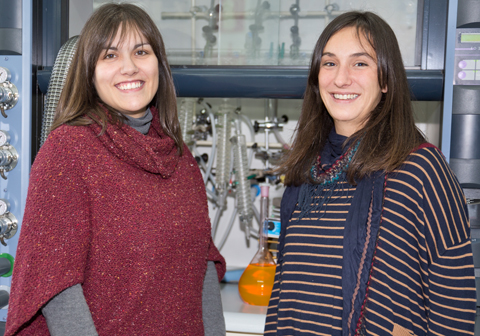Immersed in nanoscience and materials chemistry, a piece of research by the UPV/EHU is proposing a solution to fight cancer and which is a far cry from conventional treatments. Using silica nanoparticles as a support and anchoring the components needed for photodynamic therapy onto them, they have developed the way of reaching the cancer cells and acting on them alone. The key is to destroy the damaged cells by producing radioactive oxygen with the help of light.
New cancer-fighting materials using nanostructured materials helped by light
By combining organic and inorganic components, the UPV/EHU-University of the Basque Country has managed to create stable nanoparticles for photodynamic therapy
First publication date: 27/12/2016

Unlike in conventional cancer treatments, in which the healthy cells of the organism are damaged at the same time as the cancer ones, photodynamic therapy barely affects the areas that one does not want to treat. Apart from cancer, microbial cells, bacteria, fungi and viruses can also be attacked in this way. Researchers in the UPV/EHU's department of Chemical Physics have developed nanoparticles suitable for use in therapies of this type, and they are collaborating with other research groups with the aim of observing the activity of nanoparticles in vitro, "to find out how they reach cancer cells, how they destroy them, their efficiency, whether the images are clear, etc.," explained Nerea Epelde, chemist and member of the research group.
The nanoparticles synthesised by Epelde and the rest of the group consist of several components, all of them necessary and important. Firstly, the nanoparticles themselves that act as a support are spherical porous silica nanoparticles, inorganic ones, since "it has been proven that they are appropriate for other biomedical applications," she said. Secondly, they encapsulated some fluorescent molecules inside the nanoparticles, "to be able to monitor the nanoparticles and check that they reach the tumour cells," specified Epelde.
Another of the components that needed to be added to the nanoparticles were photosensitizers; "we anchored them onto the outer surface of the nanoparticles, as they are the ones used to destroy the damaged cells in photodynamic therapy. When the photosensitizer is excited by means of a light source, it is activated, and through energy transfer forms a kind of reactive cytotoxic oxygen, mainly singlet oxygen, which finishes off the tumour cells causing apoptosis or necrosis in them," she said.
Other structures and materials for different applications
Besides the nanoparticle format, they encapsulated photoactive molecules into silica structures in the form of monolith, "to obtain solid-state fluorescent materials. These materials could have a whole host of functions and uses. In our group we work with rhodamine, above all, and we have seen that in our monoliths we achieve greater fluorescent efficiency than in the solid-state materials developed in other pieces of research. Although it is true that this research has only been an initial approach, and that research in greater depth needs to be conducted to achieve greater stability in the material, prevent it from cracking, test other compounds, other synthesis methods, etc."
Leaving silica on one side, the UPV/EHU research group has also created hybrid materials of another type. The steps they followed were to use a laminated clay, saponite or laponite, as the inorganic component and insert the organic material that is the object of the study between the sheets by means of ion exchange. "That way, the organic compound ends up ordered, which is very useful to work with polarised light, for example. Among other applications it could be used as tunable, solid-state laser or as a second harmonic generator," said Epelde.
At the end of the day, hybrid materials can be of all kinds and can have a whole host of uses. "Much research into this subject is taking place worldwide as it is a field of huge interest and there is room for improvement. The research carried out has opened up several doors for us, and we will go on perfecting and improving," she concluded.
Additional information
Nerea Epelde-Elezcano (Bilbao, 1986) did all these pieces of research as part of her PhD thesis entitled Photoactive nanostructured hybrid materials for optical and biomedical applications, which she wrote up between the UPV/EHU and the UPPA (Unversite de Pau et des Pays de l'Adour), combining knowledge from both centres. Her thesis was jointly supervised by Virginia Martínez-Martínez (UPV/EHU) and Sylvie Lacombe (UUPA).


